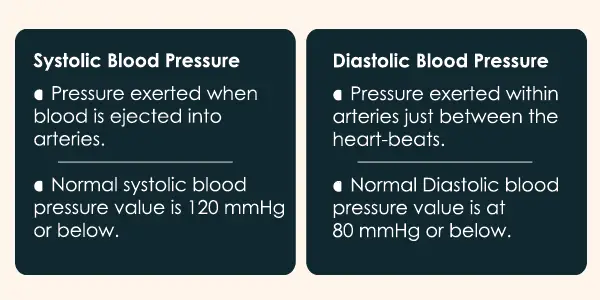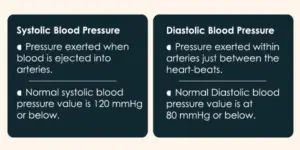
What is Blood Pressure ?
What is Blood Pressure: As the heart pumps blood to the entire body with a great force. This force puts the pressure on the blood vessels inside and this pressure is called blood pressure. We usually measure BloodPressure in millimeters of mercury (mmHg).

Systolic and Diastolic :
Systolic and Diastolic: The force/pressure when your heart pushes blood out is called systolic, usually, about 120 mmHg, while the pressure when your heart rests between beats is called diastolic pressure, usually about 80 mmHg. / 80 mmHg. These readings are normal for an average person.
Normal BP is not detectable, it will rise and fall slightly with different activity levels or mood changes. A BP monitor is used to measures the upper and lower pressures.
Upper & Under pressure
When the heart pumps the upper pressure is measured. Then the heart chases blood through the arteries.
When the heart does not pump between two pump movements the under pressure is measured.
| Upper Pressure (systolic) | Under Pressure (Diastolic) |
| The upper pressure is the highest value indicated by the BP monitor. This is the pressure in the vessels when the heart contracts. At that point, the heart pushes the blood forcefully into the arteries. The pressure on the vessel wall is then high. | The negative pressure is the lowest value indicated by the BP monitor. This is the pressure in the vessels when the heart relaxes. This happens in between 2 heartbeats. The pressure that is still there is called negative pressure. |
The hardening of the walls of the blood vessels finally leads to high BP. The vessels then constrict. This can lead to serious cardiovascular disease. That risk grows as we age.
High Blood Pressure
What Happens in High Blood Pressure: Adults whose BloodPressure continues to be above the normal range are suffering from high blood pressure. Factors that appear at different stages in the life course can affect the risk of developing high BloodPressure, such as:
- Smoking habit.
- Overweight and obesity.
- Lack of exercise.
- Too much salt in your diet.
- Excessive drinking.
- Increasing age.
- Family members have immediate family members with high blood pressure.
If hypertension is not properly treated, it can cause long term complications, including heart failure, coronary heart disease, stroke, and kidney failure, etc.
Low Blood Pressure
What is Low blood pressure: It is not a disease, but a pressure level that is lower than the normal BloodPressure range of a normal person, that is, when the systolic pressure of the body is lower than (mmHg) or diastolic BloodPressure is less than 60 millimeters of mercury (mmHg).
Low BP does not necessarily have special symptoms, and the impact on patients is not inconsistent.
Hypertension
What is Hypertension: It is a condition that occurs when the BloodPressure that represents the force of blood pushing against the walls of blood vessels is very high and It is a long term complication. According to World Health Organization the number of people suffering from Hypertension is 1.13 billion.
Prehypertension
What is Prehypertension: It is a condition when the BloodPressure readings are above the normal levels. According to the World Health Organization, prehypertension readings are between 120/80 and 139/ 89. People with this condition could develope hypertension later if left untreated or un-prevented.